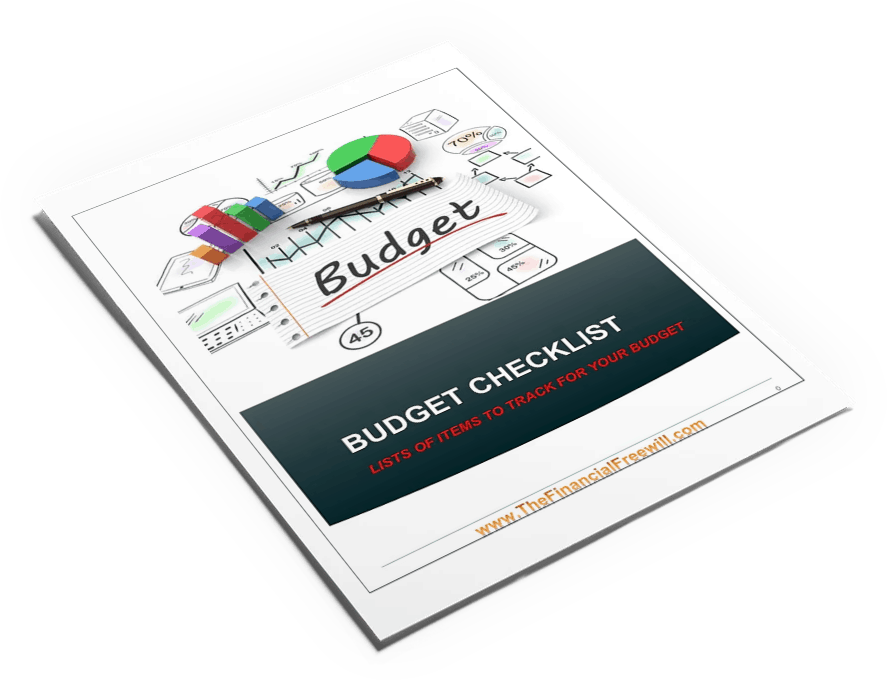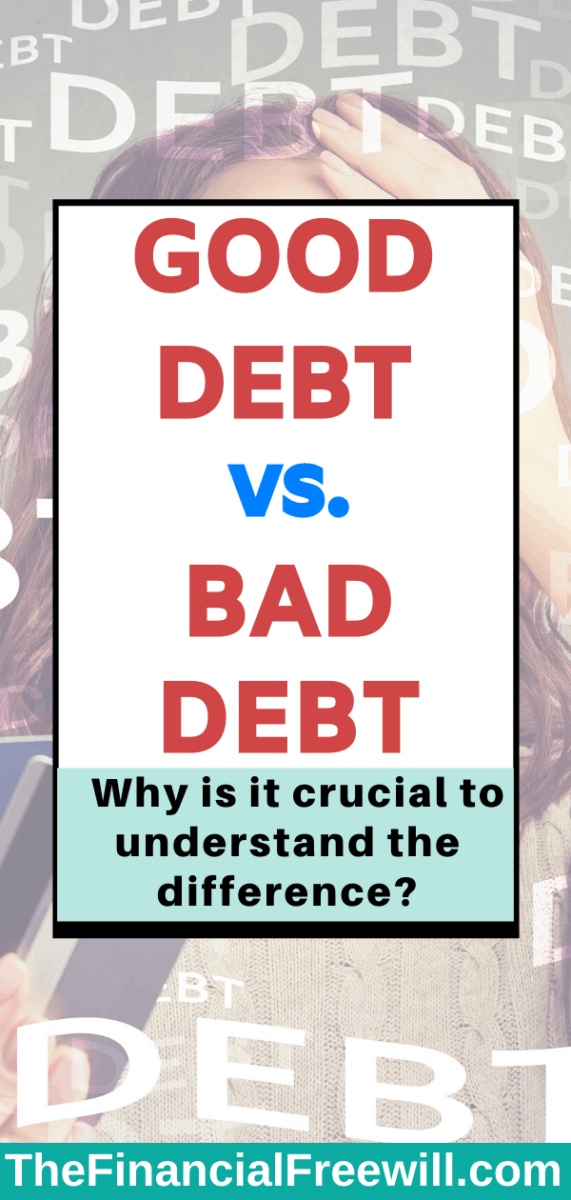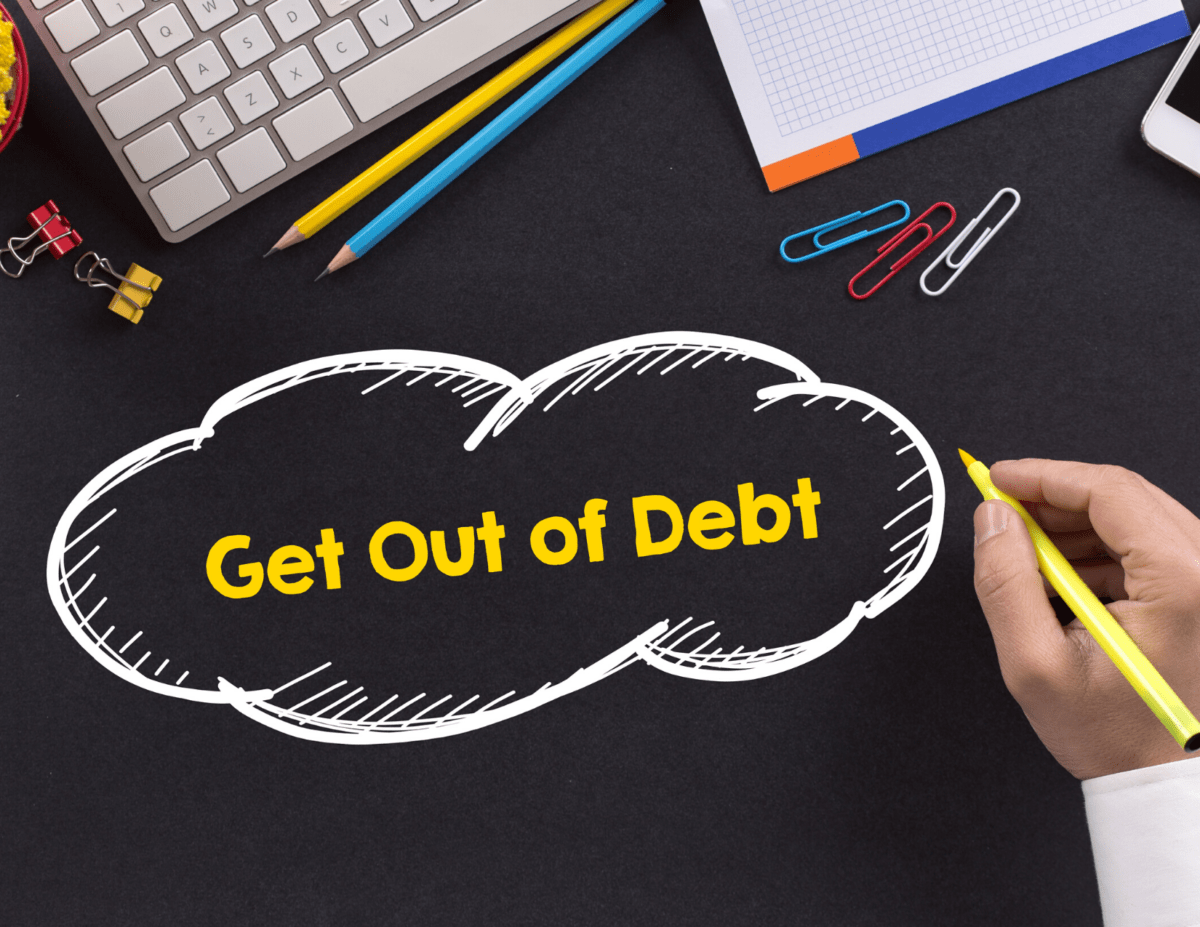This article may contain affiliate links. I might earn a small commission if you make any purchases through my links and it comes at NO cost to you. For more information, please read my Disclaimer page.
When it comes to personal finances, one of the most dreadful words is “DEBT”. Also, known as “Big D”, debt keeps most of the folks awake at night, especially millennials.
According to CNN, as of November 2019, Americans are sitting at $14 trillion in debt. Of this, close to $4 trillion is strictly credit card debt and student loan debt.
Yeah, take a deep breath and let that number sink in…
More and more people are stressed and face sleepless nights. And, the fact that most folks will keep borrowing even if they cannot pay back is simply alarming.
But, keep in mind that NOT all debts are created equal!
There is good debt and bad debt. So, it is important that you understand the difference between the two in order to achieve your financial goals.
So, let’s take a look at what is considered good debt and bad debt along with some examples.
What Is Good Debt?
In simple words, if the debt helps you increase your net worth and overall value of your investment, it is good debt. In addition, if the debt helps create more wealth than you would otherwise not be able to, it is good debt.
Mortgage
Perhaps, this is the single most crucial form of good debt you’ll take out. Investing in real estate is one of the popular forms of investment. The reason being, you can make 2 to 3 times your original investment.
When you take debt in the form of a mortgage, you are borrowing money to build your equity.
But, you need to ensure the below:
- The amount you are borrowing is well within your means AND
- You should be able to pay the monthly mortgage on 1 household income
You see, the 2008-2009 Great Recession was caused primarily because of irresponsible behavior on the consumer. The mortgage borrowers were willing to risk defaulting on their loans. And, the banks who issued these loans were greedy to a point of no return.
So, avoid putting yourself, your family and loved ones in that position.
As a general rule of thumb, your mortgage payments should not exceed 35% of your income. Ideally, keep it around 30% if you can.
To put things in perspective, if you buy a home for $300,000 and it appreciates 3% a year, at the end of your 30-year mortgage, it will be worth $728,179.
Now, that’s a good debt to have.
Student Loans
Education has always been considered an investment in your future (rightfully so). So, when it comes to student loans, most students and parents are meticulous about securing the loans.
But, very few have a plan in place on how will they repay those student loans.
As of November 2019, student loan debt was around $1.5 trillion (just in America). And, it is growing faster than the credit card debt.
So, is a student loan worth it?
It’s a BIG if – but it is only worth it if your profession is going to help you make that kind of money once you are out of college.
For example, if you are graduating in psychology, philosophy, social sciences or creative arts, your average yearly salary is around $36,000. You can be almost certain that you will not be able to pay off your student loans with that salary.
Graduating in STEM (science, technology, engineering, mathematics) fields offers you the best chances to earn a higher income. You can not only pay off your student loans but also create a life that can help you achieve financial freedom.
Download FREE Budget Checklist
>> 50+ List of Budget Items
>> Budget Items categorized into 3 sections: Income, Fixed Expenses, Variable Expenses

Small Business Loans
If you are a risk-taker and want to make an impact on people’s lives, you can start your own small business.
In order to start a small business, you can take out a small business loan as an investment in your future. If you like to work for yourself, create your own unique journey, say “no thanks” to the 9 to 5, and make more money than you would at a job, then a small business loan can really help you.
Make no mistake, building a small business is not for everyone. 1 in 3 small businesses fails in year 2. And, over 80% of small businesses fail in year 3.
In order to secure the loan, you will need a business plan, product to sell and a 3 to 5 year plan on how you are going to bring in the revenue. Small business loans are tougher to secure because of the uncertainties of success.
Home Equity Loans
When the economy is booming, businesses thriving, and home values increasing, home equity loans are pretty popular.
Why?
Because you can secure a home equity loan at a much lower interest rate.
It is basically money against your own home equity that you’ve built over the years. You can use it for various purposes like:
- Paying off higher interest credit card debt
- Renovate your house
- Upgrade your kitchen and(or) bathrooms
- Finish your basement
So, you will have 2 loans (30-year mortgage + home equity loan) to repay. The only drawback is that you might lose your house in the event you can’t make your payments toward these loans.
Hence, my recommendation would be to save money instead of any home improvement projects you’d like instead of securing a new loan.
FREE Emergency Fund Tracker!
Life is full of surprises, so why not build an emergency fund that can help you when you need it the most. Learn how to build a $1,000 fund in 77 days.
Side Hustle Loans
If you are unsure about starting a small business, you can go the side hustle route. Side hustles usually start with a hobby and you work and develop that until you are sure of converting that to a business.
Also, the upfront investment required is smaller than a small business. So, the loan amounts are usually smaller.
You can even reach out to your family members and close friends to fund the seed money. Another option is to save money from your day job and fund your side hustle.
There are numerous folks who started their side hustles from scratch and built them into million-dollar businesses. Kristin Berry of Miss Design Berry and Skot Carruth of Philosophie Group are just a couple of such examples.

What Is Bad Debt?
In simple words, debt that does not help you increase your net worth or future value of your investment is bad debt. Especially, if the debt significantly drains your finances, it could be a huge setback for you.
So, think more than twice before taking out a loan that is bad debt.
Credit Cards
The use of credit cards has completely changed consumer purchasing behavior. Total credit card debt in the US is close to $1 trillion.
So, why is using a credit card a bad debt?
There are numerous reasons but here are the top 3:
- Credit card purchases carry high-interest rates (upward of 20%) that can get you in trouble if the balance is not paid off in time
- If the full balance for the month is not paid off, you accrue interest on every purchase that was unpaid
- The minimum payment option is a trap to lure consumers to keep using the credit card while accruing mountains of debt
The use of plastic can be detrimental to your financial health if not managed efficiently.
In addition, the higher your unpaid balance on the card, the furthermore your credit score is impacted. And, if your credit score is negatively impacted, you will have to pay higher interest on any new loans or credit.
So, it is a vicious cycle of endless payments and accrued interest.
Instead, use your credit card wisely to build your credit history, earn points and redeem the points to pay off your monthly balance or airline miles.
Related Article: How To Use Your Credit Card Wisely
Download FREE Budget Checklist
>> 50+ List of Budget Items
>> Budget Items categorized into 3 sections: Income, Fixed Expenses, Variable Expenses

PayDay Loans
One of the worst options of bad debt that exists today is the payday loan. The idea of a payday loan is to lend you money when you need it. If there is a crisis and you need cash immediately, you take out a payday loan.
In return, you would write a check and post-date it (usually 2 weeks) to pay off the borrowed money plus the fee.
It’s short-term access to cash and they charge for the convenience and immediate access. The general fee for every $100 is anywhere from $20 to $40. Simply, outrageous!
Come what may avoid taking out a payday loan. Instead, create an emergency fund, that can help you in crisis and help you cover expenses you did not anticipate.
If you either do not have an emergency fund or know how to create one, don’t worry. I’ve got you covered.
Related Article: How To Create An Emergency Fund
FREE Emergency Fund Tracker!
Life is full of surprises, so why not build an emergency fund that can help you when you need it the most. Learn how to build a $1,000 fund in 77 days.
Personal Loans
Another form of bad debt that is popular is a personal loan. A personal loan can be secured for a variety of reasons from taking a vacation to renovating your home.
If you are taking on debt to enjoy time away at a beach or renovate your master bath to enjoy a jacuzzi tub, you’re in trouble.
You see, achieving financial independence requires you to make prudent decisions regarding your money. Focus on investing and growing your money and only spending on what you can afford.
Automobile Loans
Society, peer pressure, your parent’s lifestyle, and your friend’s net worth mean nothing if you are miserable and unhappy. Do not live someone else’s life if you can’t afford it – another common bad debt to avoid!
Countless folks buy a fancy car (to either keep up with the Joneses or fit in) only to realize later that it was a mistake. They can’t afford the monthly payment, and it stretches them thin.
Even if you can afford, think twice about paying an extra $300-$500 per month for a fancier version. You can save or invest that money that can earn you good returns.
The reason they are called bad debt is that your car loses around 10%-20% of the value as soon as you drive off the dealership.
An automobile is a depreciating asset. Meaning, it will only lose value as time goes by and eventually will be worthless. Unless it’s a classic one of a kind convertible.
So, if you can make good with a Ford or a Toyota, do not spend extravagantly on a Mercedez.
Download FREE Budget Checklist
>> 50+ List of Budget Items
>> Budget Items categorized into 3 sections: Income, Fixed Expenses, Variable Expenses

Final Thoughts
It is crucial to understand the difference between good and bad debt. If you do not, your financial decisions might not align with your financial goals.
The further you drift toward the bad debt with high-interest payments, the more difficult it will be to achieve your financial freedom. Both good and bad debt have their pros and cons.
But, you’d rather take on debt to grow your net worth and invest in assets that increase the future value of your investment. Also, stay away from toxic debt options like payday and personal loans.
What is your experience with good debt and bad debt? Please share your experiences, thoughts, tips, and ask away any questions in the comment section below!


This is the most succinct and easy to understand explanation of good versus bad debt I’ve come across. Thank you for using layman terms and examples to make each type of debt real.
Thanks Kimberlie 🙂
Thanks for sharing this Sam you give great details tips here that it makes sense. For those who don’t know what is an asset and a liability this will be a great article to read. I hope a lot of people can read this and know before jumping to bad debts.
Thanks April! Yes it’s really important to understand those differences.
Bad debt? Been, there, done that, never again. If I was to go into debt again, I’d shoot for good debt any day. Great post, Sam!
Thanks Corinne!
Payday loans are the worse! I understand that some people might need to resort to them, but this is the one you want to pay off first. And I agree that there are good debts, because they generally mean you invest in yourself or your future… As long as you pay it back. Great post!
Thanks Valarie!
This is helpful! As a millennial, I’m bombarded (like my peers) by all sorts of pressures to gain more debt or pay only specific debt down. This makes me feel like I’m in a much better place that I thought. I have debts, but a majority of it is ‘good’ or at least ‘unavoidable low interest okay’ debt.
Glad you found it helpful Morgan!